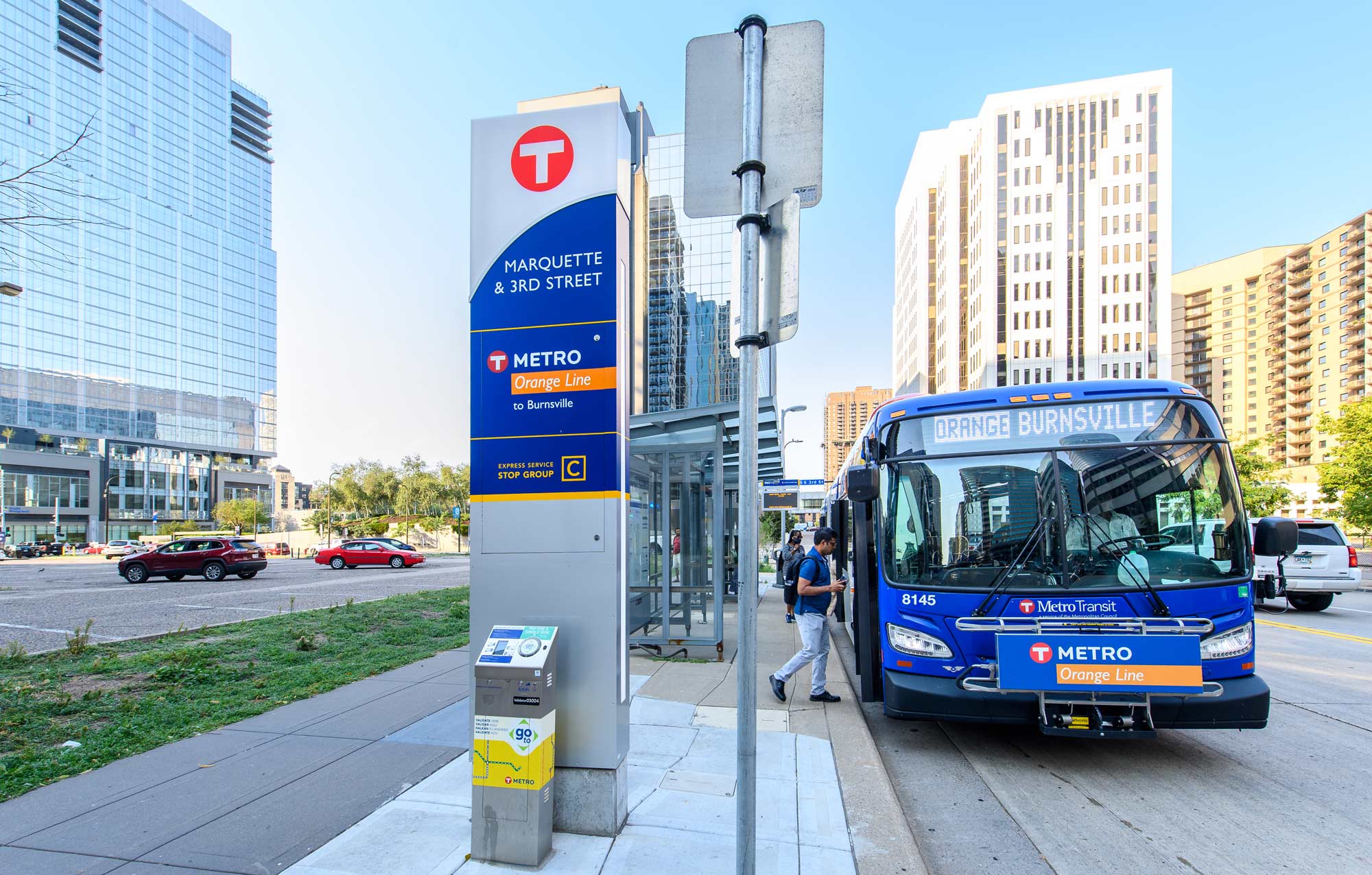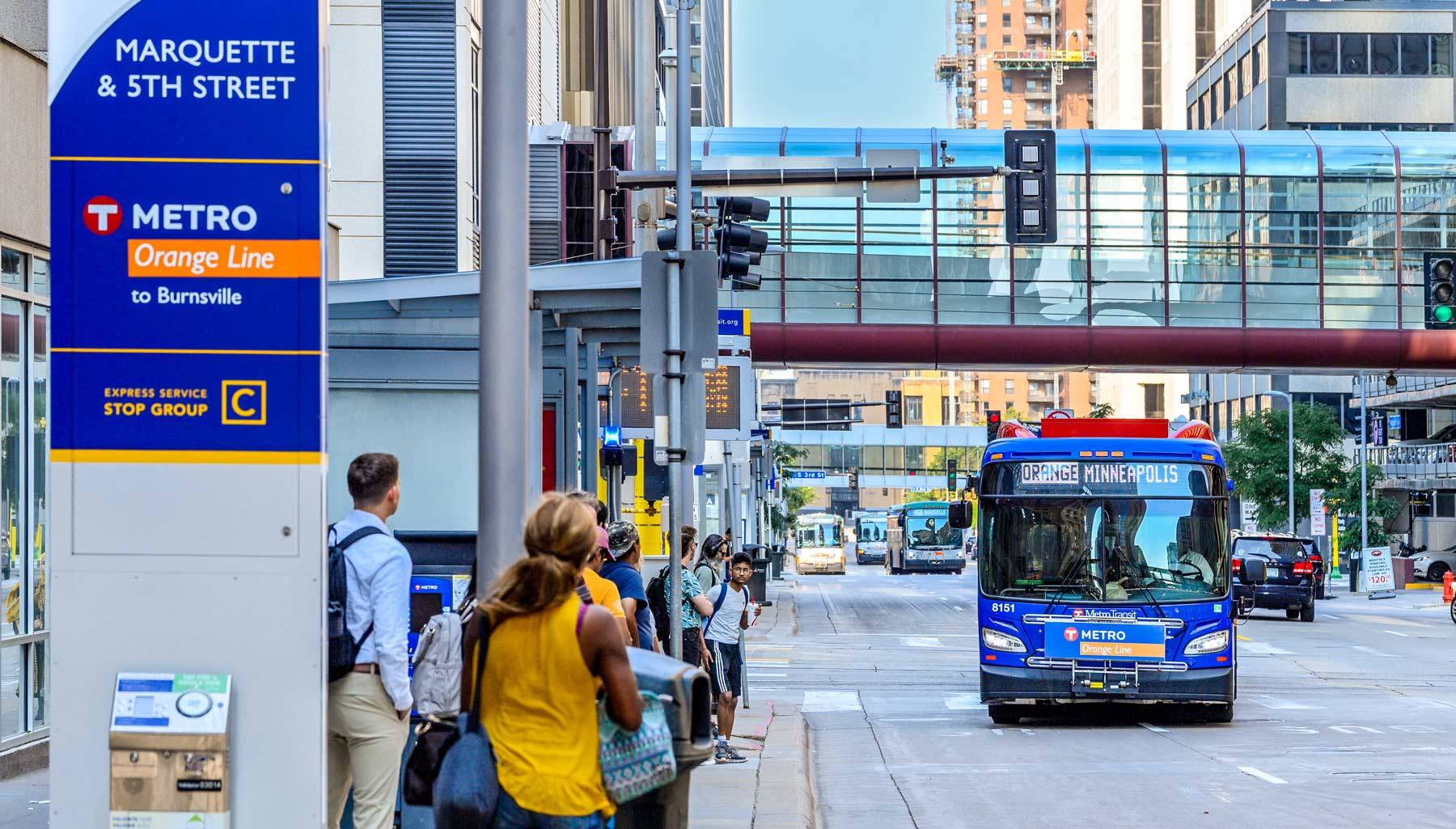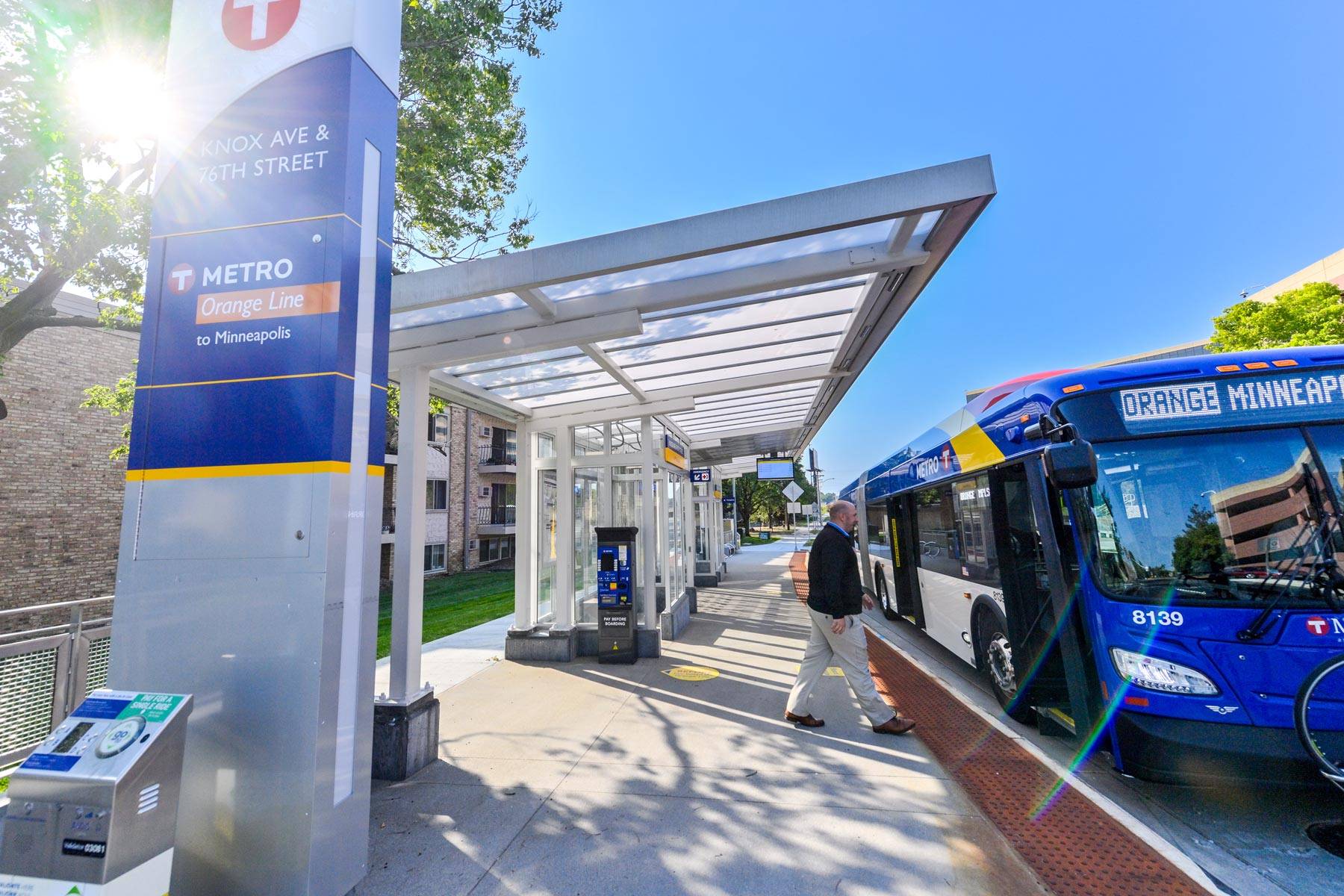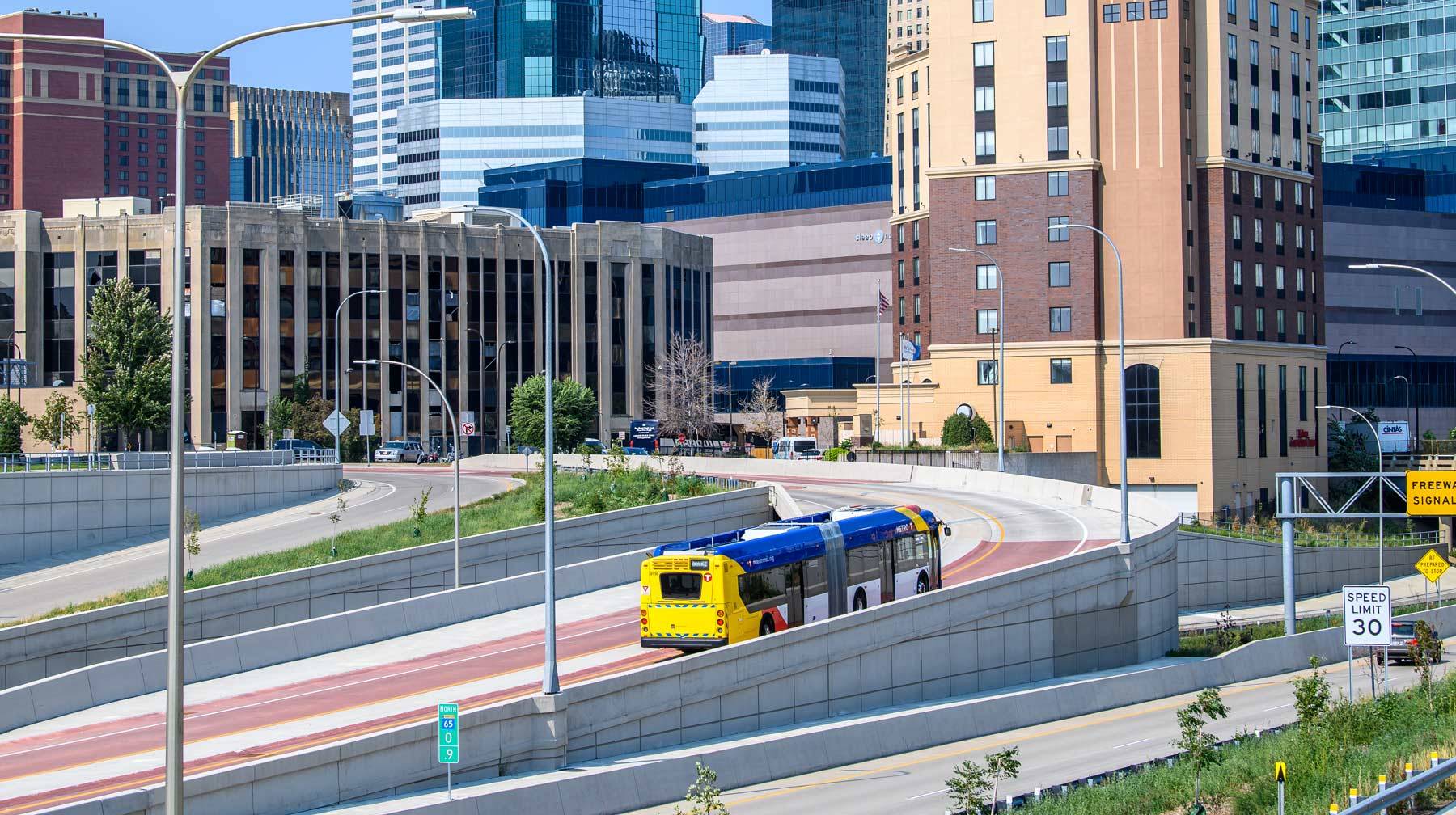
Minneapolis’ new Orange Line bus rapid transit delivers reliable, long-envisioned service to the city’s southern suburbs
DESIGNER
2023
I-35 West between downtown Minneapolis and the city’s south metro suburbs is Minnesota’s busiest commuter corridor. Regional leaders held a years-long vision for expanded bus service along the interstate that would improve access to the communities of Richfield, Bloomington and Burnsville. That goal was realized in December 2021 with the opening of the 17-mile Orange Line bus rapid transit.
Developed by Metro Transit, Minneapolis’ primary public transportation operator, the Orange Line’s frequent, all-day, seven-day-a-week service complements local and express bus routes along I-35W by providing competitive station-to-station travel times and a new option for reverse commuters — those who live in the urban core and work in the suburbs.
“Trip reliability into a downtown area is always important to transit agencies,” said Nick Spitzer, project manager for HNTB, the project’s prime consultant. “Metro Transit also focused on ensuring that the Orange Line accommodates people who are going into the suburbs for work or to businesses outside of downtown. The whole corridor now delivers that reliability, no matter which direction a rider is traveling.”
The Orange Line provides access to 198,000 jobs, including 56,000 jobs outside of downtown Minneapolis.



Dedicated guideways cut commute time
Collaboration, clear vision and innovative techniques converged to achieve the Orange Line’s success. To make the rider experience more efficient, minimize the heavily congested interstate corridor’s impact on travel times and reduce conflict points where accidents could occur, the project was designed to have 10% of the Orange Line operating in dedicated guideways. Those areas include:
- Knox Avenue Transitway. The Orange Line’s dedicated lanes showpiece is the new Knox Avenue Transitway, Minnesota’s first bus-only tunnel, which passes under I-494, one of the busiest stretches of highway in the state. Using this direct route under the freeway reduces travel time between 76th and 82nd Streets by 10 minutes.
The project team was tasked with minimizing disturbance to the heavily traveled I-494 corridor during construction of the bus-only tunnel. Tunnel design also had to accommodate a new turbine interchange that will be built at the location when the Minnesota Department of Transportation reconstructs the nearby I-35W/I-494 interchange.
To maintain I-494 traffic while the Transitway was being built, Metro Transit, HNTB and project partner MnDOT elected to build the tunnel in halves. This decision allowed the southbound I-494 lanes to remain open as the north half of the tunnel was built below, reducing travel delays for commuters and opening one full side of the freeway for tunnel construction. The process then was flipped for the southern half of tunnel construction.
- 12th Street ramp at I-35W. A new bi-directional, transit-only flyover ramp moves buses on and off the freeway at 12th Street as they come into and out of downtown.
“Before the Orange Line was built, buses entering downtown used to sit in traffic on 11th Street and had to navigate around parking,” said Metro Transit Project Manager Derek Berube. “In the afternoons, buses sat in traffic on the old 12th Street ramp to get out of downtown. Buses had to merge into Highway 65 traffic from the right, and sometimes multiple buses would be stuck on the ramp, racking up delay for hundreds of passengers in the peak hours.”
The new ramp crosses over Highway 65. Where shoulders were pushed out to accommodate the dedicated flyover lanes, HNTB needed to gain additional vertical clearance at the structure to meet design standards. This was achieved by lowering the roadways approximately 1 foot at the 15th Street bridge along Highway 65.
The roads also were widened closer to the bridge abutment, reducing the unused space in front of the existing abutment to zero feet. For this to work without closing the 15th Street bridge during construction, the team used a soil nail wall in front of an existing bridge abutment to preserve right-of-way without impacting the structure.
The road widening placed the 12th Street ramp close to a downtown hotel. At that location, the project team placed a soldier pile wall, built using top-down construction. Rather than having to excavate to the bottom of the retaining wall, the soldier pile wall allowed piles to be driven in, with excavation and panel placement completed as the construction team went.
The 12th Street ramp alleviates one of the Metro Transit network’s most congested points, provides a seamless connection for 700 bus trips each day and improves trip time and reliability for I-35W transit riders. After buses enter 12th Street from the ramp, they counterflow general traffic, moving west in a dedicated lane that ties into the two roads that service the four downtown Metro Transit stations.
- Lake Street Station. Continuing south from 12th Street, the iconic new Lake Street Station stands between the northbound and southbound lanes of I-35W. Multiple transit routes connect at the station. Buses exiting the freeway enter a dedicated center station platform bridge that allows customers to board both the Orange Line and I-35W express bus routes on the freeway level. The bus-only guideway removed previous bus weave across three lanes.
- 46th Street Station. South of the Lake Street Station, the I-35W and 46th Street Station opened in 2010 as the first BRT station constructed in Minneapolis. The Orange Line uses dedicated lanes that already served two local bus routes. With the Orange Line project, Metro Transit updated signage and ticket machines in the station.
Delivering benefits to area communities
The large Orange Line corridor is diverse, encompassing suburban and urban residential areas, employment centers and the downtown core. Population demographics vary greatly along the corridor, with high-income and low-income residential areas in both Minneapolis and the suburbs.
Initial planning determined that the Orange Line offered a dramatic opportunity to provide traditionally underrepresented communities along the route with equitable, affordable access to jobs and other services.
Before the Orange Line was constructed, individuals in these communities sometimes had to take multiple bus lines and make several stops to reach their destinations. The Orange Line established a single, more-direct service line that offers trainlike features, including ADA-compliant, heated stations with bus schedules, ticket vending machines, seating under canopies and bicycle parking. Branded vehicles distinguish the Orange Line service. Stations were placed purposefully at the points where they would be most utilized, providing convenience, travel reliability and improved connections.
Of the 195,000 people within walking distance of the Orange Line, 18% live with an income below the poverty level. The new line provides much-needed infrastructure for all community members to reach recreation activities, school, employment centers and grocery stores as an affordable alternative to private vehicles.
Opening economic development opportunity
The Orange Line stations not only serve the riders who use it for their daily commutes, but also promote economic growth opportunities in adjacent properties.
The Twin Cities region has experienced a booming economy in recent years, with development trends increasing. In nine of the 12 Orange Line station areas, the project team identified more than 260 sites, totaling 375 acres, that are suitable for transit-supportive, higher-density development or redevelopment.
Most of the immediate station areas in Richfield, Bloomington and Burnsville allow medium- to high-density residential development. The connection from downtown Minneapolis also will promote other growth in the city’s southern suburbs. Bloomington, for example, has leveraged the Orange Line’s presence in its Penn American District mixed-use redevelopment project, which includes more than 100,000 square feet of residential, retail and hotel space.
Model for BRT standards in Minneapolis
Upon opening, the Orange Line saw 11 straight months of steep ridership growth, despite the continuing COVID-19 pandemic. By March 2023, average weekday ridership was 1,187 — up 42% over the same month in 2022. There was no weekend service before the Orange Line opened. Average daily ridership on weekends now is 400 to 500.
As the region’s second highway BRT system, the Orange Line connects people across the region to job centers, housing options and destinations in the corridor. In addition to expanded accessibility, it promotes and complements walkable neighborhoods in the station areas.
“The Orange Line serves as a model for BRT standards in Minneapolis,” said Metro Transit Project Manager Christina Morrison. “It embraces core elements of BRT planning and is an example of how each corridor has to identify and implement the right set of tools to improve access to riders, increase on-time performance and provide a comfortable, accessible trip.”
SEE MORE ARTICLES
MORE DESIGNER STORIES
I-4 Ultimate
Fish Passage
Dallas Love Field
CID Green Infrastructure Project
Denver International Airport
